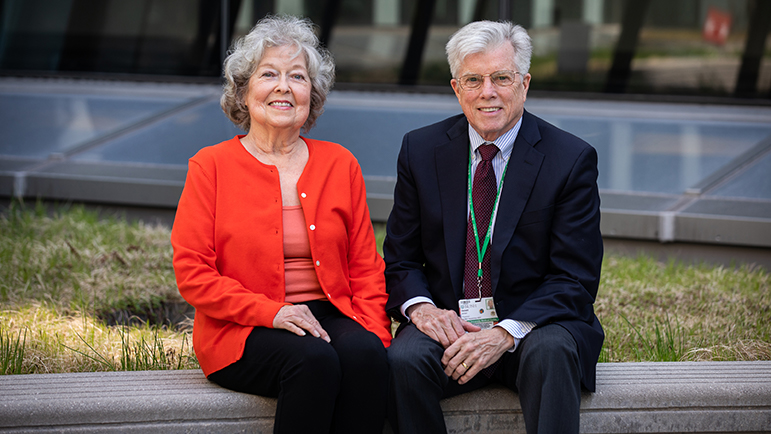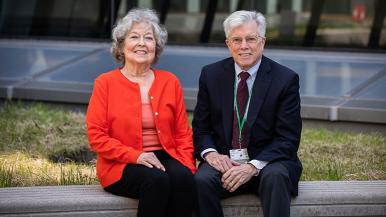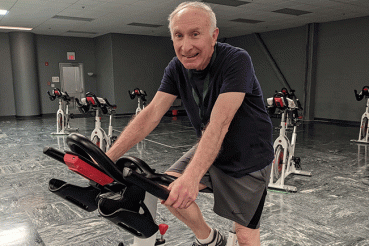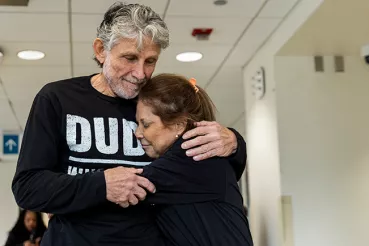It was 1986. Nancy Gardner had just given birth to her third child when she began experiencing strange symptoms.
“I started to notice my skin and eyes turn green, my hair had a purple cast to it, and I had stomach issues and a high fever,” Nancy says. “I was so sick and my whole body was being affected.”
Nancy went to a hospital near her home in La Grange Park, where her test results came back normal. But her health continued to decline.
Rush stepped in to help
Nancy was referred to the hepatology team at Rush, who determined her liver was failing.
“Nancy did not have a lot of time to live without a liver transplant,” says Donald Jensen, MD, a hepatologist at Rush, who helped treat Nancy and coordinate her care. “And with the severity of her condition, she was considered a priority candidate.”
To prepare for a transplant at Rush — one of the first transplant programs in the country — each recipient goes through a comprehensive evaluation to make sure they’re well enough for the procedure.
“We look at their cardiac and pulmonary function, check for cancer, and consider whether they are smokers and or heavy drinkers. We also do psychosocial evaluation to make sure they have support after the transplant,” Jensen says. “And since Nancy was a young, relatively healthy adult with a large family, we didn’t have any major concerns.”
By Memorial Day weekend, a match was found from a deceased donor, and Nancy underwent a successful transplant — becoming one of the first patients to get a liver transplant at Rush.
"Everyone reacted, stepped in and helped our situation — I felt very fortunate."
Recovering from a transplant
Moved to intensive care after her surgery, Nancy experienced a few side effects — including difficulty walking and talking, as well as issues with her vision.
“Although I was awake, I couldn’t express myself — I was terrified,” Nancy says. “But my care team brought my family to visit the hospital one day, which brought comfort to a scary situation.”
While in the hospital, her care team checked her scars, performed bloodwork and biopsies to make sure her liver was working properly. She also received physical therapy and speech therapy and saw an eye doctor regularly.
“I was slowly getting better thanks to the care at Rush,” Nancy says. “I couldn’t have had a better team.”
Adjusting to normal life
Nancy finally went home after a month in the hospital. But adjusting to normal life wasn’t easy.
“It was definitely hard to be home with my kids given the mental and physical effects from everything,” Nancy says. “I think it was toughest for my 5-year-old daughter Shannon, but she would come to my appointments and recognized I was receiving excellent care, which later inspired her to become a nurse.”
By August, Nancy was back taking care of kids and enjoying time with her family.
A setback
Nancy did have a setback a few years later, when adhesions — or scarring — from the transplant required more surgery.
“It was disheartening, but I have always been determined to push forward,” Nancy says.
After a few weeks of recovery, Nancy healed from her second procedure. And now, 36 years later, Nancy’s liver continues to be healthy and strong.
“Livers through transplant are good for the rest of your life if you take care of them, and people can return to a relatively normal life,” Jensen says. “Even with some setbacks, Nancy has done remarkably well for having a transplant so long ago.”

‘I believe in organ donation’
Organ donation can be life-changing, and Nancy wants to inspire others in her situation.
“My life shattered when I was ill, but I made it because of organ donation and it’s important I share my experience with others,” she says. “I want others to have hope, too.”
Nancy feels grateful to the family of her liver donor, and she understands the unique challenge of donating a family member’s organs.
In 2001, Nancy’s daughter Shannon died in a hit-and-run accident at age 20.
“The grief was so overwhelming,” Nancy says. “But my husband and I donated Shannon’s organs (heart, kidney and liver) so someone else could live. We did that as her wish.”
“I encourage everyone to consider organ donation — it can truly save lives.”




